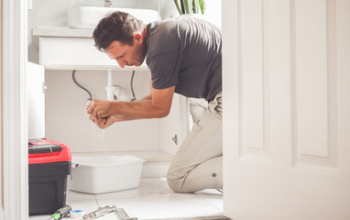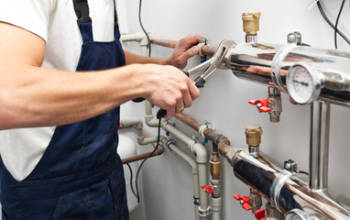Plumbing Shreveport projects can be undertaken if you’re a homeowner and want to save money on plumber costs. With the right tools, you can install kitchen or bathroom fixtures.
Specific parts of your plumbing system may malfunction, but most of the time, these issues don’t culminate into major problems. Learn about the following easy DIY plumbing to make your home safer.

Whether you’re remodeling your bathroom or building a new one, faucets and shower heads are easy DIY projects that almost anyone can tackle. However, it’s important to recognize your limits and not attempt plumbing installations that are beyond your capabilities. This will help you avoid major problems down the road and save time and money.
Almost all tub and shower faucets can be replaced without redoing the plumbing by unscrewing the old ones and screwing on the new ones. But replacing a shower head can be trickier because the screws holding it in place are often tightened with rust shavings and can become stuck. It’s also important to know that not all shower heads are interchangeable, so you must purchase the right replacement for your existing unit.
Before you begin a project like this, shut off your home’s water supply. This will prevent any accidental water leaks and make cleanup easier. You should also lay a tarp or garbage bag over your bathtub to protect it from rust shavings or other debris that might fall off during the process.
First, remove the handle and trim from the faucet. This can usually be done by unscrewing the handles from the wall or using a screwdriver to remove any covers over the handle or a set screw beneath it. Once the handles are removed, you can remove the spout nipple and flange (the part that sits in the tub) by loosening the nuts that connect them to the faucet body. Next, unscrew the valve stem from the spout and disconnect the supply tubes from it.
Finally, cut the old shower riser pipe (the tube that runs from the ceiling to the showerhead). If you have an old galvanized pipe, you’ll need to install a special coupler before connecting it to your new shower head. After cutting the pipe, make sure it is flush with the wall and apply Teflon pipe sealant to both ends of the new connection. Finally, screw on the new shower head and tighten it by hand — don’t use a tool to overtighten, which could damage it or lead to leaks.
A bad caulking job around your tub can lead to water damage, mold, or rot. If you notice that the current caulking is discolored, loose or cracked, it’s time to replace it with a new, waterproof bead of caulk. This is one of the most common DIY plumbing projects, and it’s surprisingly easy to do.
Before you begin, make sure to remove any mildew or soap scum from the seams between your bathtub and tile wall surface. Then, wipe down the seams with denatured alcohol to clean them and ensure that they are dry. Mask the corner gaps with painter’s tape before you start caulking the tub to avoid getting caulk on the corners of the wall or tiles.
Next, use a utility knife or box cutter to cut away the old caulk. Be careful not to cut the actual tub. You can also use a painters’ scraper or razor scraper to help you remove stubborn bits of caulk from the edges of your bathtub. Make sure to put a stopper in your drain to prevent bits of old caulk from falling down into it.
You can use a silicone caulk or acrylic latex, but it’s important to choose the right type for your bathroom. If you’re using silicone, be sure to get a product that is mold-resistant and non-toxic. If you’re using acrylic latex, be sure to buy a paintable version and pick one that is mildew-resistant.
Once you’ve chosen the correct type of caulk for your needs, load your caulking gun and apply it as directed on the package. Make sure you follow the drying instructions carefully because some caulking products take as little as 30 minutes to dry before they can be exposed to moisture.
You can also use a wet paper towel to smooth out the caulk bead, but you should let it dry completely before using the tub. It’s best to give the caulk a full day to fully cure before you expose it to water again, so be patient! By following these simple tips, you can caulk a bathtub with ease and enjoy your newly-renovated bathroom for years to come.
Plumbing may seem like an intimidating home improvement task, but with a little bit of patience and some easy DIY plumbing techniques, almost anyone can save money and repair small problems by taking on a few simple projects. Whether you are replacing a leaky faucet, clogged drain or even fixing a water heater, learning the basics of your home’s plumbing system will allow you to tackle many small tasks with ease.
First, find the main water shutoff valve in your home and locate it so you will be able to turn off the water in an emergency. This is the most important plumbing fix any homeowner can do, and it will make the biggest difference in saving money on repairs.
Next, shut off the power to the water heater. Attach a garden hose to the drainage valve at the bottom of the water heater and connect it to a drain. Open the drain valve to let the water drain out. If you need to, remove the access cover and fold back the insulation. If you are replacing a gas water heater, shut off the gas supply valve.
Remove the old water tank and disconnect the hot and cold water pipes at the drain valves and at the top of the tank. Be sure to wear protective gear when handling a gas water heater, as it can be very heavy and filled with sediment, which could cause damage if not removed properly.
Using a pipe wrench, remove the existing gas line from the venting valve on the water heater and connect the new one. Ensure the gas pipe is tightly connected to the valve. Use a pipe cutter and tubing wrench for compression or union fittings, and a pipe wrench or channel lock pliers for soldered connections.
Before reinstalling the element, check for electric power with a volt meter or circuit tester. Remove the plastic terminal protector, then insert the electric wires into their appropriate terminals and tighten screws. Replace the access cover and insulation.
Lastly, drain and flush the new water heater to remove any sediment that may be trapped inside. Once the tank is empty, close the drain valve and connect the new water line. When you turn on the water, only fill the tank until it’s full to prevent rusting of the heating elements. After that, test the pressure by turning on a hot water faucet in a room other than where the water heater is located. If the faucet bubbles, you have a leak and will need to call in a plumber.
A water filter improves the quality of your home’s water and saves you a lot of money on bottled water. While many people install a filter on the kitchen sink faucet, it is possible to install a whole-house filtration system that connects directly to the main water line and filters all of the house’s water at once. If you are experienced with tools and plumbing, a whole-house filter installation is an easy DIY project.
A faucet filter can be attached to the sink’s existing drinking water spout, but it is also possible to attach the device to the cold water pipe itself using special saddle valves that snap onto the outside of your pipes. This type of filter is ideal for under-sink installation and requires a bit more effort than installing it on the sink faucet spout, but it will still only filter cold water, not hot water from the tap.
The first step is to shut off the cold-water supply valve under the sink by closing it and turning it clockwise. It may be helpful to place a bucket or tray underneath the valve to catch any water that is likely to drip out. If you have a plastic water line that goes from the valve to the faucet, close it too. Then, use a wrench to disconnect the faucet riser and remove it. If your new water filter comes with a saddle valve that can be screwed onto the pipe, use an adjustable wrench for the compression fitting above and a sink wrench for the one at the faucet. Then, use a tubing cutter to cut out a section of pipe, making sure to leave enough room for the valve to be installed on the new end.
Next, screw the new valve onto the pipe and connect the faucet to it using the adaptor that came with your kit. Make sure that you have a washer on each side of the faucet to keep it from leaking, and put Teflon pipe tape around the threads of any adapters you may need. Lastly, screw the filter faucet head or adaptor to the faucet and insert the filter. Most filters require a test run to make sure that they are working properly, so be sure to turn the faucet back on and let it run for about a minute.


